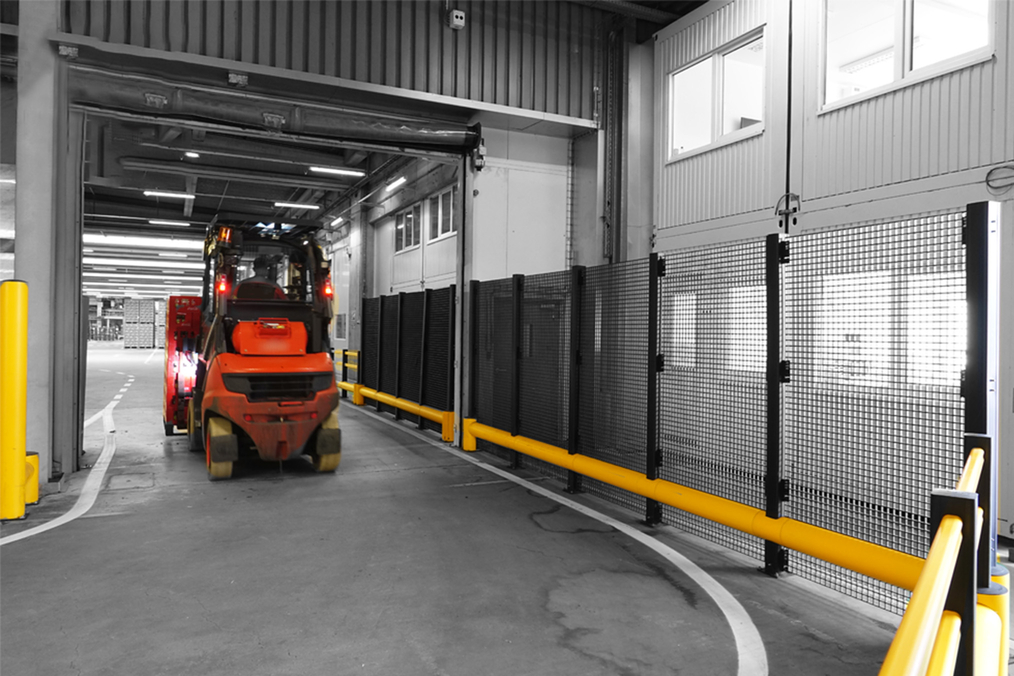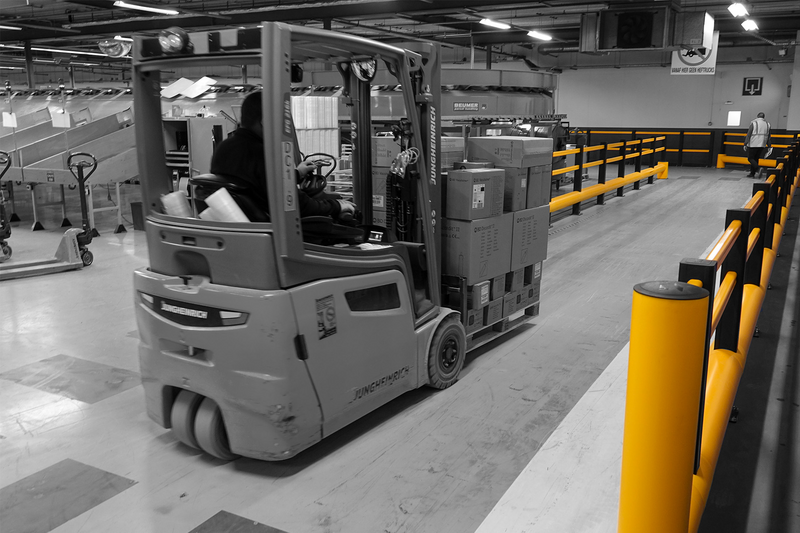Are you aware of the 10 most frequent forklift accidents?
Forklift accidents continue to make up a significant percentage of all workplace accidents. This shouldn't be surprising, as forklifts are used for many different tasks in various situations. Since they share the work environment with numerous road users and pedestrians, this can lead to serious accidents if effective safety measures are not implemented, such as polymer safety barriers. Learn about the 10 most frequent forklift accidents below.

1. Collision with a forklift
Frequency: 41%
A UK study has shown that three-quarters of forklift accidents are caused by poor workplace layout and, specifically, poor segregation of vehicular and pedestrian traffic. This significantly increases the risk of collisions, so it's no surprise that this is the number one cause of forklift accidents. The impact of a forklift collision should not be underestimated. For example, they can cause serious injuries to people. Alternatively, a forklift collision can cause damage to buildings, machinery, goods, or other vehicles.
To prevent forklifts from crossing paths with pedestrians, your workplace should have a clear traffic plan designating separate paths for vehicles and pedestrians.
However, pedestrians and forklifts will inevitably be in proximity at some point. This is why it's important to take both prevention and protection measures. Make forklifts more visible by painting them in eye-catching colors and providing fluorescent vests for pedestrians. Most importantly, install safety barriers where needed. This will not only increase awareness but also provide effective protection for pedestrians, infrastructure, buildings, and other vehicles in case of a collision.
Ready to improve workplace safety? Boplan offers a wide range of polymer safety barrier solutions to equip your warehouse as needed.
2. Falling goods
Frequency: 17%
If a forklift makes an improper maneuver or must turn unexpectedly to avoid an operator or obstacle, the load on the fork may fall. Depending on the type of load, this could result in serious injury or damage. Discover how to prevent falling objects in your workplace here.
3. Falling from heights
Frequency: 12%
Forklifts are not designed as aerial work platforms. Nevertheless, forklifts are often used to lift workers to a certain height to perform specific tasks. Forklifts are not intended to lift people. The worker must be cautious not to fall. Unfortunately, this cannot always be guaranteed.
Make employees aware of the risk of falling from a forklift through verbal instructions and/or a safety presentation, and by posting safety rules in the work area. Providing safety equipment for working at heights can also help ensure employees work safely in the future.
4. Tipping over sideways
Frequency: 7%
A forklift may tip over if it drives onto a sloping platform, over a bump, or across an uneven surface. This can also happen if it has to make a sudden turn. This could result in the operator being thrown from the cab or pinned between the forklift and the ground or a wall.
Many of these risks can be eliminated by capping the speed limit in the workplace. Of course, even if you set and communicate speed limits internally, drivers may still exceed them when time is tight. This endangers both themselves and those around them. To ensure drivers adhere to the speed limit, install a speed limiter in the truck. This ensures the driver works efficiently and safely without speeding. One solution is the TruckLog Speed Zoning system. It uses infrared technology to automatically adjust the maximum speed to the conditions in each zone.
You can also install additional safety equipment besides the seat belt or safety bar in the forklift itself. Seat belts are the most budget-friendly (and essential) option, but they provide the least protection. It can be tempting for the driver to clip the belt behind their back without using it, especially in situations where they frequently get out of the forklift. An option to consider is a 'stream belt'. This is a belt installed in front of the cab entrance, requiring the operator to put it on when entering the cab.
Brace doors also provide additional protection for the cab in the event of an accident. A swing door is another variation. These work on the same principle as brace doors, but the driver can open them by pushing the door upwards. This allows the driver to enter and exit the forklift easily in confined spaces.
A fully enclosed cab remains the best solution for complete safety. Besides protecting the driver from the elements, dust, and debris, it minimizes the risk of being crushed in a rollover – provided the operator drives with the cab closed.
5. Tilting forward
Frequency: 7%
A forklift can tip over if it's overloaded or if the load is picked up without due care. This not only endangers the operator and bystanders but can cause serious damage to the building, the truck, and the load.
Ensure you know the forklift's maximum capacity. This information is typically clearly marked on the vehicle itself. It's also important to load the forklift correctly. Even if it's not at maximum capacity, the load can throw the forklift off balance if the goods are not balanced on the forks.
6. Entrapment
Frequency: 6%
There are several ways a worker can become trapped while operating a forklift. If someone places their hand or leg too close to the truck, they can get trapped between the chain or fork. Similarly, a bystander standing too close between the forklift and a wall can be trapped when the vehicle maneuvers.
Always give forklifts enough space and avoid forcing them through narrow aisles. Make sure aisles are well-lit and safe by using floor markings or physical safety solutions like safety barriers. Instruct workers not to touch the forklift, even if it's not in operation. Forklift operators must keep their arms and legs inside the cab.
7. Injury when entering or exiting
Frequency: 4%
There is always a risk of injury. As operators gain experience in their daily tasks, they can become careless when entering and exiting the forklift. Depending on the height between the cab and the ground, a simple trip could result in an injury that would leave the person unable to work for a period.
The best way to prevent this is straightforward: pay attention. Be cautious when getting off. Exit the forklift as you would descend a ladder: backward. This helps prevent sprains.
8. Technical malfunctions
Frequency: 3%
Forklifts are mechanical and electronic, so there is always a risk of malfunctions. A fork can come loose, brakes can fail, or the fuel line may leak, etc.
Therefore, it's crucial to have forklifts inspected regularly. Additionally, it is vital to check internal circuits and test the forklift's primary functions before beginning work.
9. Platform incidents
Frequency: 2%
In some warehouses, forklifts are operated on platforms. Depending on the platform's condition, incidents can occur due to platform collapse or the truck falling off.
Install extra safety barriers on the platform to prevent forklifts from driving off. Choose heavy-duty kick rails with handrails or safety barriers with handrails. This offers the best protection. Also, avoid obstacles or uneven surfaces on platforms or mezzanine levels. Learn how to prevent falls from heights here.
10. Parking accidents
Frequency: 2%
It may not seem likely, but incidents can occur even when a forklift is parked. A slight steering error can cause a forklift to damage a building or, worse, hit another worker while turning.
Clearly mark the floors in parking zones and at forklift loading docks. Use bollards or kick rails on nearby walls to prevent damage in case of a collision.
Conclusion
The specific types of forklift accidents are less important than actually minimizing the risk of any accident. Now that you know the top ten forklift accidents, you can prepare for them by implementing various safety measures. While communication and training are initial steps, remember that no workplace is completely immune to accidents just by implementing safety rules.
Consider installing safety barriers as a standard practice. Polymer safety barriers not only help prevent accidents but also protect pedestrians, machinery, buildings, infrastructure, and other vehicles. This means that even if disaster strikes, you'll be prepared and ready for impact.
Interested in how to enhance workplace safety? Read one of our industry-specific white papers to learn which safety barriers are best for your business.
